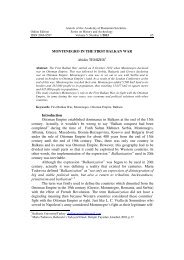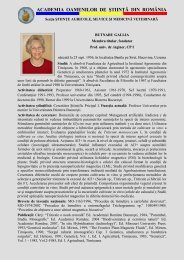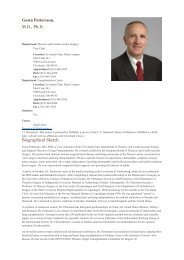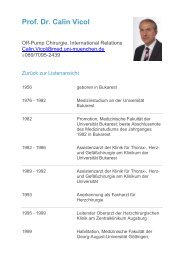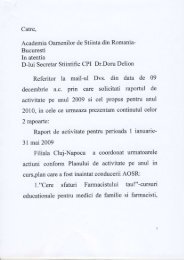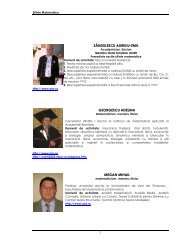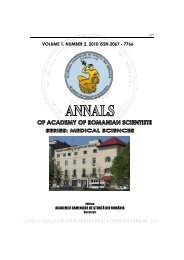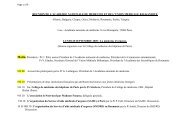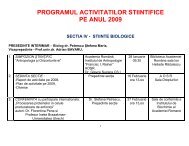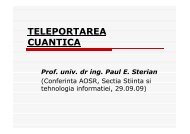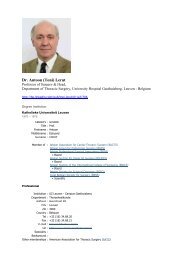Volume 3 nr 1 / 2011 - Academia Oamenilor de Stiinta din Romania
Volume 3 nr 1 / 2011 - Academia Oamenilor de Stiinta din Romania
Volume 3 nr 1 / 2011 - Academia Oamenilor de Stiinta din Romania
- No tags were found...
You also want an ePaper? Increase the reach of your titles
YUMPU automatically turns print PDFs into web optimized ePapers that Google loves.
128 Alexandru Ionuț Chiuță, Liviu Mihai Sima, Nicoleta Doriana Secăreanuperturbation (distortion) introduced in the signal line, measured between IMGBDepot and Unirii 2 stations, and is correlated with the "hopping" potential levels.They are variable along the tunnel and approximately equal to the average of thelatter. From measurements it was found that the disturbances level that penetratesthe coaxial line is favoured by low insulation resistance of the coaxial cablebetween stations. This parameter shows large fluctuations over time. For example,the insulation resistance between the signal cable exterior armature to the groundbelt between Piata Sudului and Constantin Brancoveanu stations varies between400kΩ/1kV and 100MΩ/1kV. The minimum acceptable insulation resistance isconsi<strong>de</strong>red to be at least 10MΩ/1kV (15MΩ/1kV).Un<strong>de</strong>r these conditions the following situations are possible:- CCTV signal cable has the screen interrupted or portions without screen (cablequality);- CCTV cable groun<strong>din</strong>g is not done properly.Measurements ma<strong>de</strong> show that the "hopping" potentials on the tunnel an<strong>de</strong>lectromagnetic influences make impossible the i<strong>de</strong>a of changing the arrangementof the tunnel coaxial lines to ensure a minimum acceptable of the insulatio<strong>nr</strong>esistance.Penetration of the disturbance in the CCTV installation takes place from electricpower fee<strong>din</strong>g and earth contact, as well. Assessment of the perturbation level inthe fee<strong>din</strong>g power network was done by measuring on all 20 kV busbars andgeneral distribution panels (GDPs) in all stations of the entire Subway Line II.Also, measurements were ma<strong>de</strong> at TGDs in the Unirii 1 station: dispatch area, onthe camera and monitors.Groun<strong>din</strong>g belt of CCTV installations in stations is heavily perturbed.Comparison of the segments of earth belt between stations shows, in terms ofgroun<strong>din</strong>g of the disturbances, a critical sizing (for CCTV installations) and / oran untidy construction and / or inappropriate execution of groun<strong>din</strong>g of theelectrical equipment in Subway Line II and the CCTV system respectively.Interaction between the CCTV cable and groun<strong>din</strong>g belt is so strong that, evenwith <strong>de</strong>coupling, disturbances are still very high.3.4.3. Susceptibility to disturbances of CCTV chainRegar<strong>din</strong>g the susceptibility to disturbances of the CCTV chain and possibility ofincreasing immunity to disturbances, it was found that CCTV equipment is notqualified for operation un<strong>de</strong>r conditions of disturbances.From this point of view, the standards of industry products mention, in the chapterof "environmental conditions", that the equipment is <strong>de</strong>signed for operation inenvironments free from strong electromagnetic fields and disturbances.Copyright © Editura Aca<strong>de</strong>miei <strong>Oamenilor</strong> <strong>de</strong> Știință <strong>din</strong> România, <strong>2011</strong>Watermark Protected



